Organisational Behaviour Report: Culture, Motivation, Team Dynamics
VerifiedAdded on 2020/06/06
|12
|4040
|70
Report
AI Summary
This report provides a comprehensive analysis of organisational behaviour within A David & Co Limited, a food and beverage company based in Bristol. It examines the influence of culture, politics, and power on individual employees and team dynamics, highlighting the importance of a strong organisational culture and effective management of diverse teams. The report delves into the impact of content and process theories of motivation on goal achievement, including reinforcement theory, McGregor's Theory X and Y, ERG theory, and Herzberg's Motivation-Hygiene theory. Furthermore, it contrasts effective and ineffective team structures, outlining the key steps in building an efficient, goal-oriented team, including leadership selection, clear goal setting, and fostering a positive work environment. The report emphasizes the importance of factors like communication, conflict resolution, and employee empowerment in creating a successful and productive organisational environment.
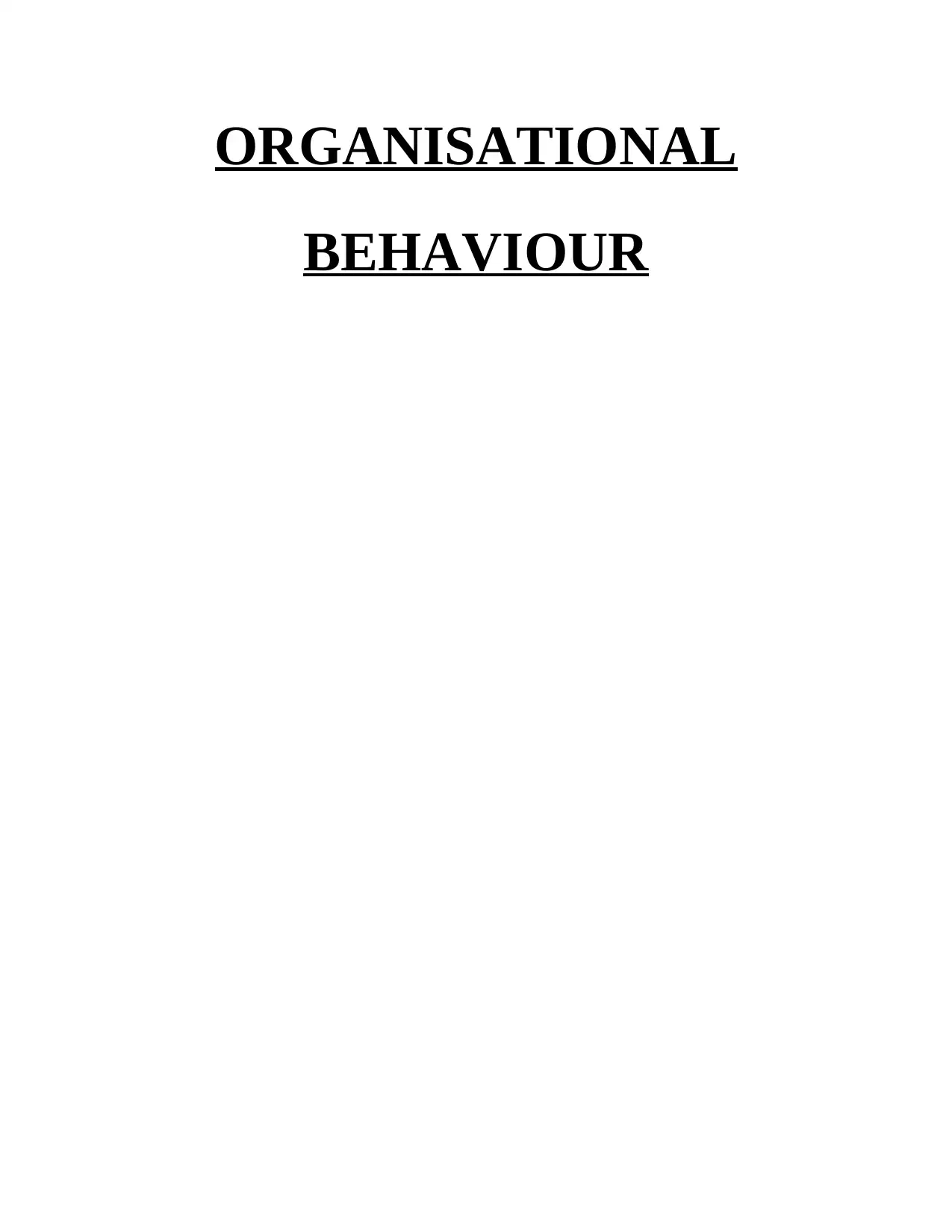
ORGANISATIONAL
BEHAVIOUR
BEHAVIOUR
Paraphrase This Document
Need a fresh take? Get an instant paraphrase of this document with our AI Paraphraser
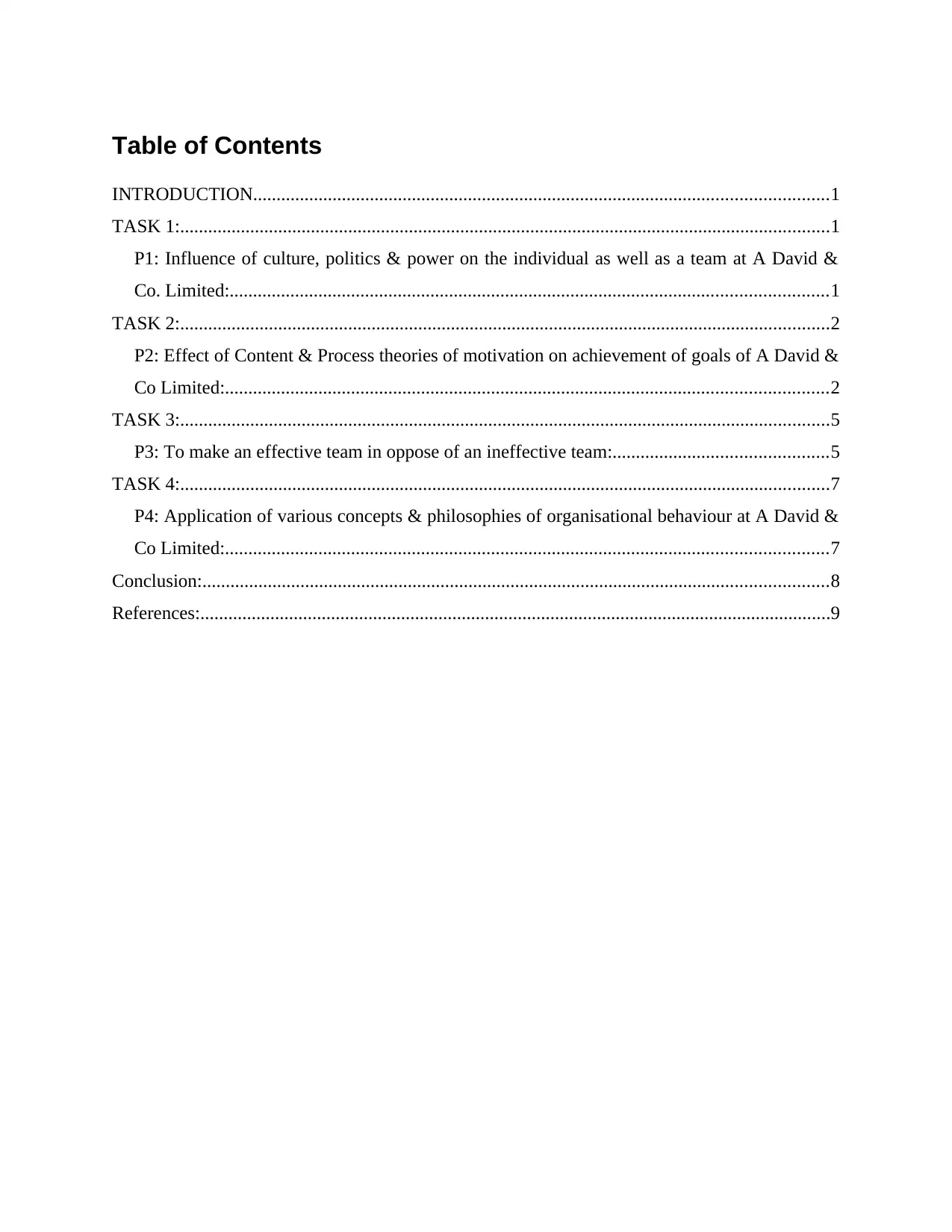
Table of Contents
INTRODUCTION...........................................................................................................................1
TASK 1:...........................................................................................................................................1
P1: Influence of culture, politics & power on the individual as well as a team at A David &
Co. Limited:................................................................................................................................1
TASK 2:...........................................................................................................................................2
P2: Effect of Content & Process theories of motivation on achievement of goals of A David &
Co Limited:.................................................................................................................................2
TASK 3:...........................................................................................................................................5
P3: To make an effective team in oppose of an ineffective team:..............................................5
TASK 4:...........................................................................................................................................7
P4: Application of various concepts & philosophies of organisational behaviour at A David &
Co Limited:.................................................................................................................................7
Conclusion:......................................................................................................................................8
References:.......................................................................................................................................9
INTRODUCTION...........................................................................................................................1
TASK 1:...........................................................................................................................................1
P1: Influence of culture, politics & power on the individual as well as a team at A David &
Co. Limited:................................................................................................................................1
TASK 2:...........................................................................................................................................2
P2: Effect of Content & Process theories of motivation on achievement of goals of A David &
Co Limited:.................................................................................................................................2
TASK 3:...........................................................................................................................................5
P3: To make an effective team in oppose of an ineffective team:..............................................5
TASK 4:...........................................................................................................................................7
P4: Application of various concepts & philosophies of organisational behaviour at A David &
Co Limited:.................................................................................................................................7
Conclusion:......................................................................................................................................8
References:.......................................................................................................................................9
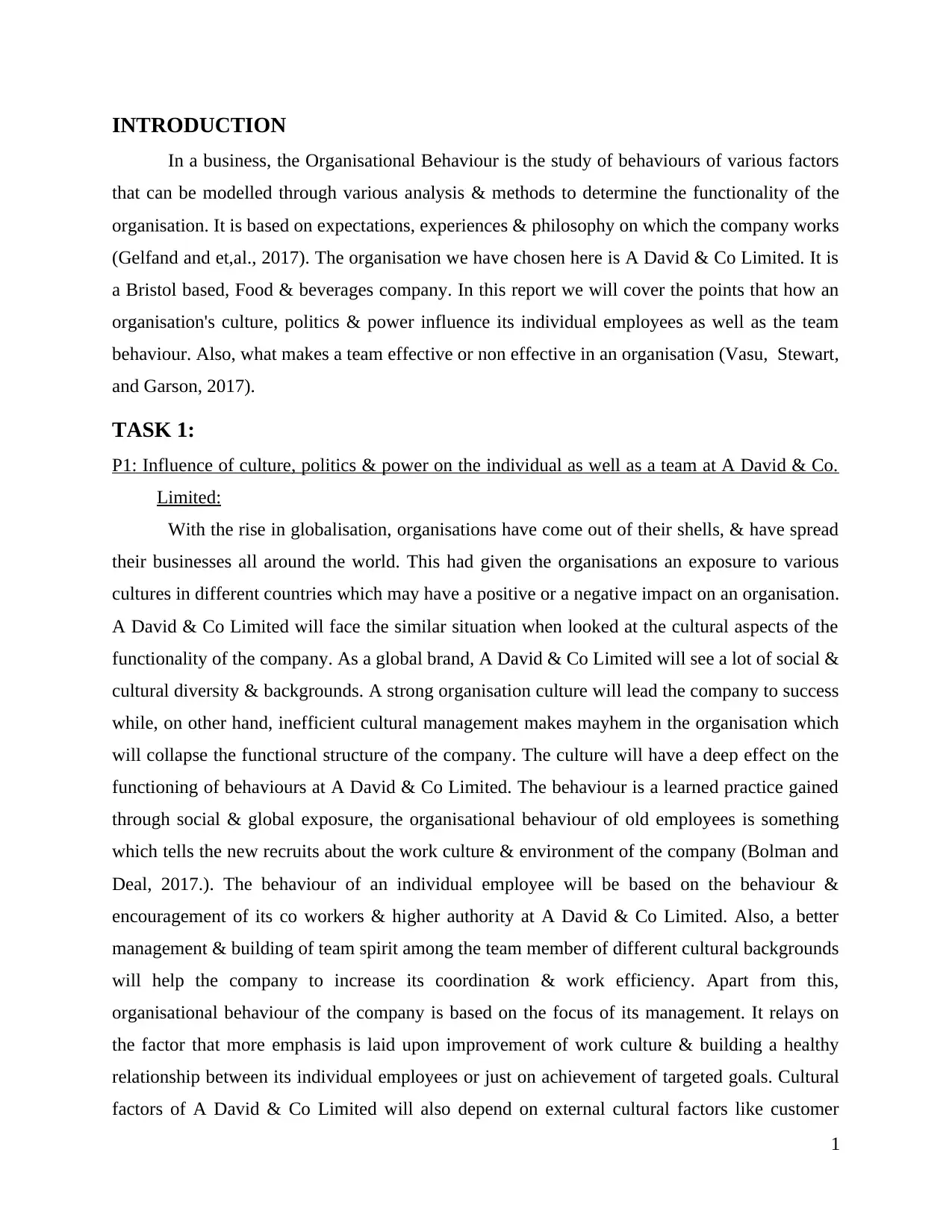
INTRODUCTION
In a business, the Organisational Behaviour is the study of behaviours of various factors
that can be modelled through various analysis & methods to determine the functionality of the
organisation. It is based on expectations, experiences & philosophy on which the company works
(Gelfand and et,al., 2017). The organisation we have chosen here is A David & Co Limited. It is
a Bristol based, Food & beverages company. In this report we will cover the points that how an
organisation's culture, politics & power influence its individual employees as well as the team
behaviour. Also, what makes a team effective or non effective in an organisation (Vasu, Stewart,
and Garson, 2017).
TASK 1:
P1: Influence of culture, politics & power on the individual as well as a team at A David & Co.
Limited:
With the rise in globalisation, organisations have come out of their shells, & have spread
their businesses all around the world. This had given the organisations an exposure to various
cultures in different countries which may have a positive or a negative impact on an organisation.
A David & Co Limited will face the similar situation when looked at the cultural aspects of the
functionality of the company. As a global brand, A David & Co Limited will see a lot of social &
cultural diversity & backgrounds. A strong organisation culture will lead the company to success
while, on other hand, inefficient cultural management makes mayhem in the organisation which
will collapse the functional structure of the company. The culture will have a deep effect on the
functioning of behaviours at A David & Co Limited. The behaviour is a learned practice gained
through social & global exposure, the organisational behaviour of old employees is something
which tells the new recruits about the work culture & environment of the company (Bolman and
Deal, 2017.). The behaviour of an individual employee will be based on the behaviour &
encouragement of its co workers & higher authority at A David & Co Limited. Also, a better
management & building of team spirit among the team member of different cultural backgrounds
will help the company to increase its coordination & work efficiency. Apart from this,
organisational behaviour of the company is based on the focus of its management. It relays on
the factor that more emphasis is laid upon improvement of work culture & building a healthy
relationship between its individual employees or just on achievement of targeted goals. Cultural
factors of A David & Co Limited will also depend on external cultural factors like customer
1
In a business, the Organisational Behaviour is the study of behaviours of various factors
that can be modelled through various analysis & methods to determine the functionality of the
organisation. It is based on expectations, experiences & philosophy on which the company works
(Gelfand and et,al., 2017). The organisation we have chosen here is A David & Co Limited. It is
a Bristol based, Food & beverages company. In this report we will cover the points that how an
organisation's culture, politics & power influence its individual employees as well as the team
behaviour. Also, what makes a team effective or non effective in an organisation (Vasu, Stewart,
and Garson, 2017).
TASK 1:
P1: Influence of culture, politics & power on the individual as well as a team at A David & Co.
Limited:
With the rise in globalisation, organisations have come out of their shells, & have spread
their businesses all around the world. This had given the organisations an exposure to various
cultures in different countries which may have a positive or a negative impact on an organisation.
A David & Co Limited will face the similar situation when looked at the cultural aspects of the
functionality of the company. As a global brand, A David & Co Limited will see a lot of social &
cultural diversity & backgrounds. A strong organisation culture will lead the company to success
while, on other hand, inefficient cultural management makes mayhem in the organisation which
will collapse the functional structure of the company. The culture will have a deep effect on the
functioning of behaviours at A David & Co Limited. The behaviour is a learned practice gained
through social & global exposure, the organisational behaviour of old employees is something
which tells the new recruits about the work culture & environment of the company (Bolman and
Deal, 2017.). The behaviour of an individual employee will be based on the behaviour &
encouragement of its co workers & higher authority at A David & Co Limited. Also, a better
management & building of team spirit among the team member of different cultural backgrounds
will help the company to increase its coordination & work efficiency. Apart from this,
organisational behaviour of the company is based on the focus of its management. It relays on
the factor that more emphasis is laid upon improvement of work culture & building a healthy
relationship between its individual employees or just on achievement of targeted goals. Cultural
factors of A David & Co Limited will also depend on external cultural factors like customer
1
⊘ This is a preview!⊘
Do you want full access?
Subscribe today to unlock all pages.

Trusted by 1+ million students worldwide
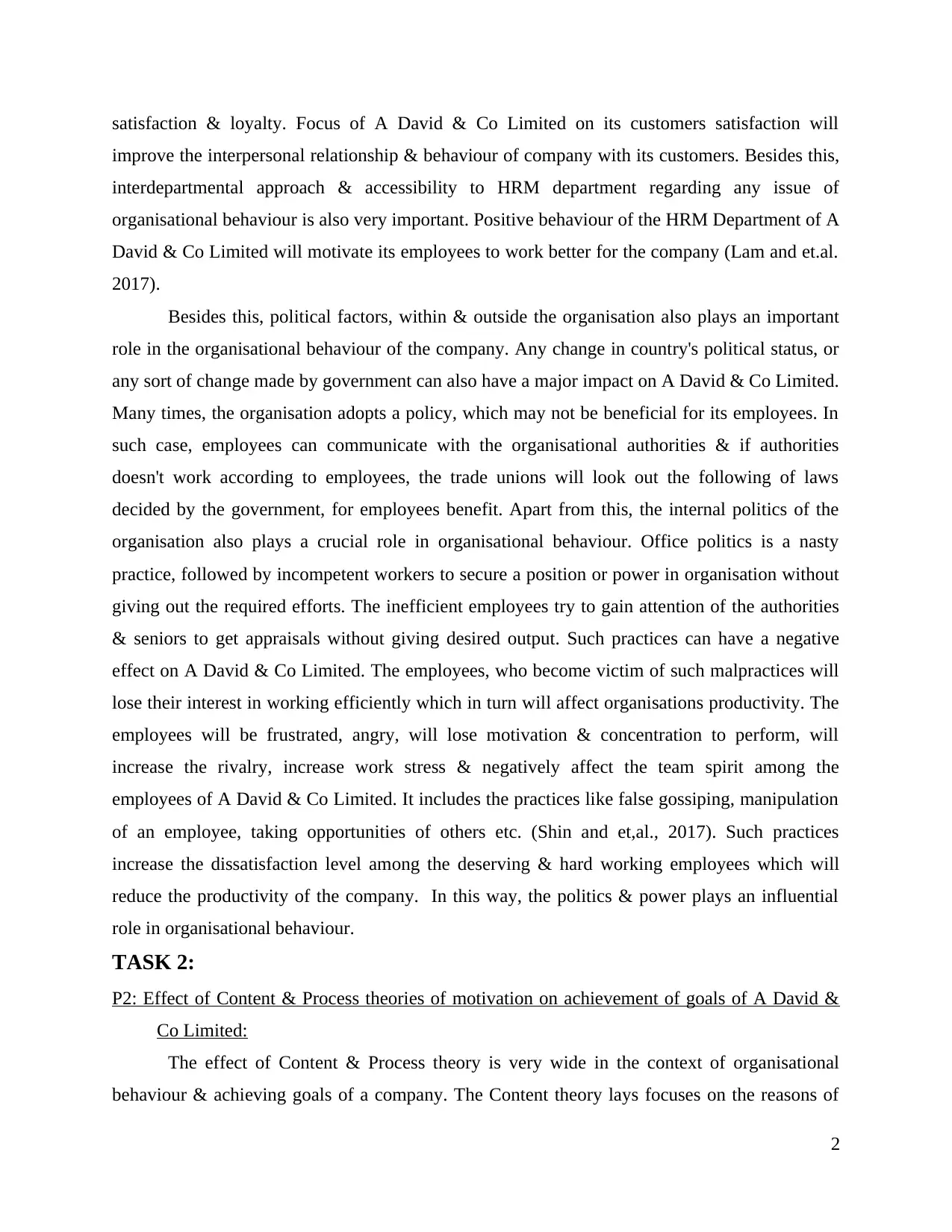
satisfaction & loyalty. Focus of A David & Co Limited on its customers satisfaction will
improve the interpersonal relationship & behaviour of company with its customers. Besides this,
interdepartmental approach & accessibility to HRM department regarding any issue of
organisational behaviour is also very important. Positive behaviour of the HRM Department of A
David & Co Limited will motivate its employees to work better for the company (Lam and et.al.
2017).
Besides this, political factors, within & outside the organisation also plays an important
role in the organisational behaviour of the company. Any change in country's political status, or
any sort of change made by government can also have a major impact on A David & Co Limited.
Many times, the organisation adopts a policy, which may not be beneficial for its employees. In
such case, employees can communicate with the organisational authorities & if authorities
doesn't work according to employees, the trade unions will look out the following of laws
decided by the government, for employees benefit. Apart from this, the internal politics of the
organisation also plays a crucial role in organisational behaviour. Office politics is a nasty
practice, followed by incompetent workers to secure a position or power in organisation without
giving out the required efforts. The inefficient employees try to gain attention of the authorities
& seniors to get appraisals without giving desired output. Such practices can have a negative
effect on A David & Co Limited. The employees, who become victim of such malpractices will
lose their interest in working efficiently which in turn will affect organisations productivity. The
employees will be frustrated, angry, will lose motivation & concentration to perform, will
increase the rivalry, increase work stress & negatively affect the team spirit among the
employees of A David & Co Limited. It includes the practices like false gossiping, manipulation
of an employee, taking opportunities of others etc. (Shin and et,al., 2017). Such practices
increase the dissatisfaction level among the deserving & hard working employees which will
reduce the productivity of the company. In this way, the politics & power plays an influential
role in organisational behaviour.
TASK 2:
P2: Effect of Content & Process theories of motivation on achievement of goals of A David &
Co Limited:
The effect of Content & Process theory is very wide in the context of organisational
behaviour & achieving goals of a company. The Content theory lays focuses on the reasons of
2
improve the interpersonal relationship & behaviour of company with its customers. Besides this,
interdepartmental approach & accessibility to HRM department regarding any issue of
organisational behaviour is also very important. Positive behaviour of the HRM Department of A
David & Co Limited will motivate its employees to work better for the company (Lam and et.al.
2017).
Besides this, political factors, within & outside the organisation also plays an important
role in the organisational behaviour of the company. Any change in country's political status, or
any sort of change made by government can also have a major impact on A David & Co Limited.
Many times, the organisation adopts a policy, which may not be beneficial for its employees. In
such case, employees can communicate with the organisational authorities & if authorities
doesn't work according to employees, the trade unions will look out the following of laws
decided by the government, for employees benefit. Apart from this, the internal politics of the
organisation also plays a crucial role in organisational behaviour. Office politics is a nasty
practice, followed by incompetent workers to secure a position or power in organisation without
giving out the required efforts. The inefficient employees try to gain attention of the authorities
& seniors to get appraisals without giving desired output. Such practices can have a negative
effect on A David & Co Limited. The employees, who become victim of such malpractices will
lose their interest in working efficiently which in turn will affect organisations productivity. The
employees will be frustrated, angry, will lose motivation & concentration to perform, will
increase the rivalry, increase work stress & negatively affect the team spirit among the
employees of A David & Co Limited. It includes the practices like false gossiping, manipulation
of an employee, taking opportunities of others etc. (Shin and et,al., 2017). Such practices
increase the dissatisfaction level among the deserving & hard working employees which will
reduce the productivity of the company. In this way, the politics & power plays an influential
role in organisational behaviour.
TASK 2:
P2: Effect of Content & Process theories of motivation on achievement of goals of A David &
Co Limited:
The effect of Content & Process theory is very wide in the context of organisational
behaviour & achieving goals of a company. The Content theory lays focuses on the reasons of
2
Paraphrase This Document
Need a fresh take? Get an instant paraphrase of this document with our AI Paraphraser
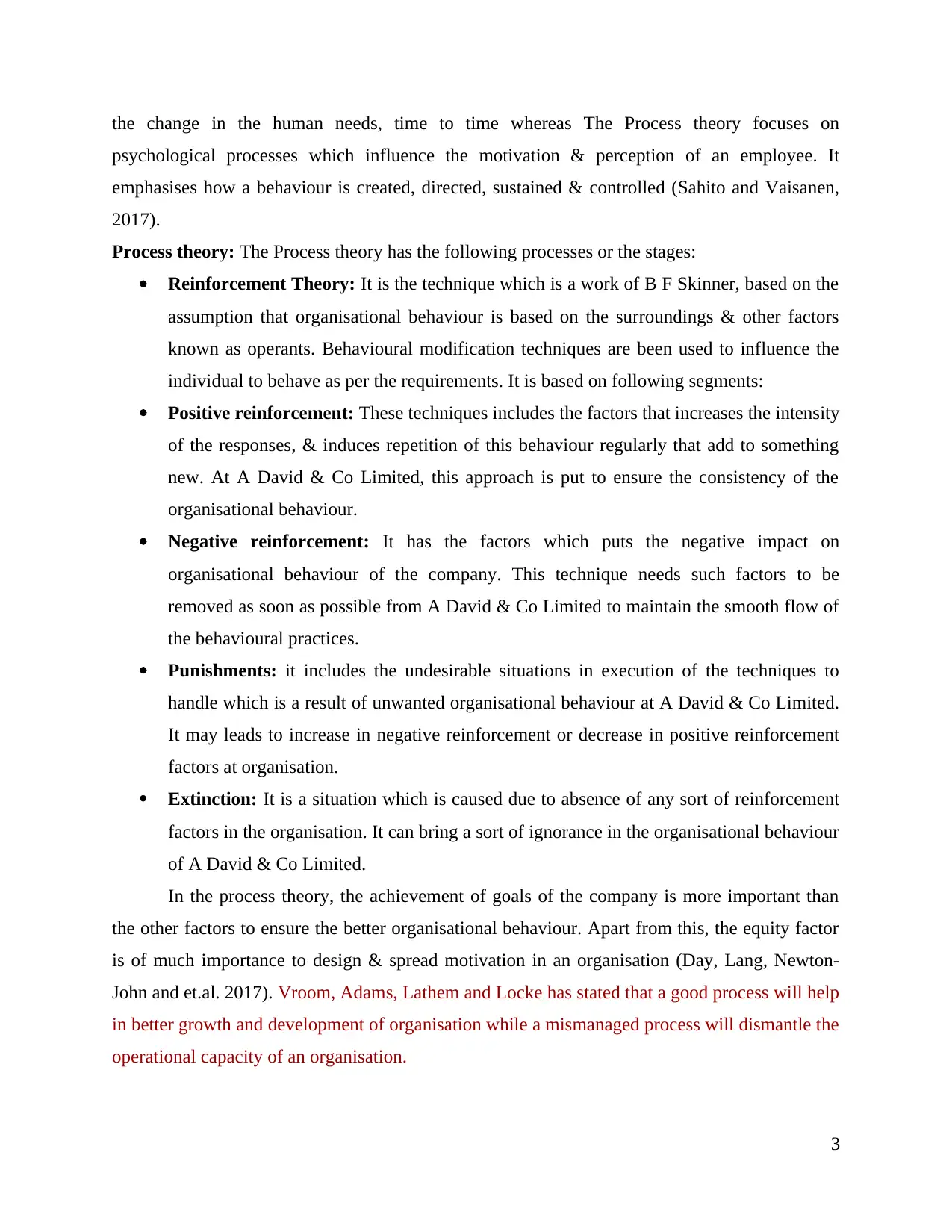
the change in the human needs, time to time whereas The Process theory focuses on
psychological processes which influence the motivation & perception of an employee. It
emphasises how a behaviour is created, directed, sustained & controlled (Sahito and Vaisanen,
2017).
Process theory: The Process theory has the following processes or the stages:
Reinforcement Theory: It is the technique which is a work of B F Skinner, based on the
assumption that organisational behaviour is based on the surroundings & other factors
known as operants. Behavioural modification techniques are been used to influence the
individual to behave as per the requirements. It is based on following segments:
Positive reinforcement: These techniques includes the factors that increases the intensity
of the responses, & induces repetition of this behaviour regularly that add to something
new. At A David & Co Limited, this approach is put to ensure the consistency of the
organisational behaviour.
Negative reinforcement: It has the factors which puts the negative impact on
organisational behaviour of the company. This technique needs such factors to be
removed as soon as possible from A David & Co Limited to maintain the smooth flow of
the behavioural practices.
Punishments: it includes the undesirable situations in execution of the techniques to
handle which is a result of unwanted organisational behaviour at A David & Co Limited.
It may leads to increase in negative reinforcement or decrease in positive reinforcement
factors at organisation.
Extinction: It is a situation which is caused due to absence of any sort of reinforcement
factors in the organisation. It can bring a sort of ignorance in the organisational behaviour
of A David & Co Limited.
In the process theory, the achievement of goals of the company is more important than
the other factors to ensure the better organisational behaviour. Apart from this, the equity factor
is of much importance to design & spread motivation in an organisation (Day, Lang, Newton‐
John and et.al. 2017). Vroom, Adams, Lathem and Locke has stated that a good process will help
in better growth and development of organisation while a mismanaged process will dismantle the
operational capacity of an organisation.
3
psychological processes which influence the motivation & perception of an employee. It
emphasises how a behaviour is created, directed, sustained & controlled (Sahito and Vaisanen,
2017).
Process theory: The Process theory has the following processes or the stages:
Reinforcement Theory: It is the technique which is a work of B F Skinner, based on the
assumption that organisational behaviour is based on the surroundings & other factors
known as operants. Behavioural modification techniques are been used to influence the
individual to behave as per the requirements. It is based on following segments:
Positive reinforcement: These techniques includes the factors that increases the intensity
of the responses, & induces repetition of this behaviour regularly that add to something
new. At A David & Co Limited, this approach is put to ensure the consistency of the
organisational behaviour.
Negative reinforcement: It has the factors which puts the negative impact on
organisational behaviour of the company. This technique needs such factors to be
removed as soon as possible from A David & Co Limited to maintain the smooth flow of
the behavioural practices.
Punishments: it includes the undesirable situations in execution of the techniques to
handle which is a result of unwanted organisational behaviour at A David & Co Limited.
It may leads to increase in negative reinforcement or decrease in positive reinforcement
factors at organisation.
Extinction: It is a situation which is caused due to absence of any sort of reinforcement
factors in the organisation. It can bring a sort of ignorance in the organisational behaviour
of A David & Co Limited.
In the process theory, the achievement of goals of the company is more important than
the other factors to ensure the better organisational behaviour. Apart from this, the equity factor
is of much importance to design & spread motivation in an organisation (Day, Lang, Newton‐
John and et.al. 2017). Vroom, Adams, Lathem and Locke has stated that a good process will help
in better growth and development of organisation while a mismanaged process will dismantle the
operational capacity of an organisation.
3
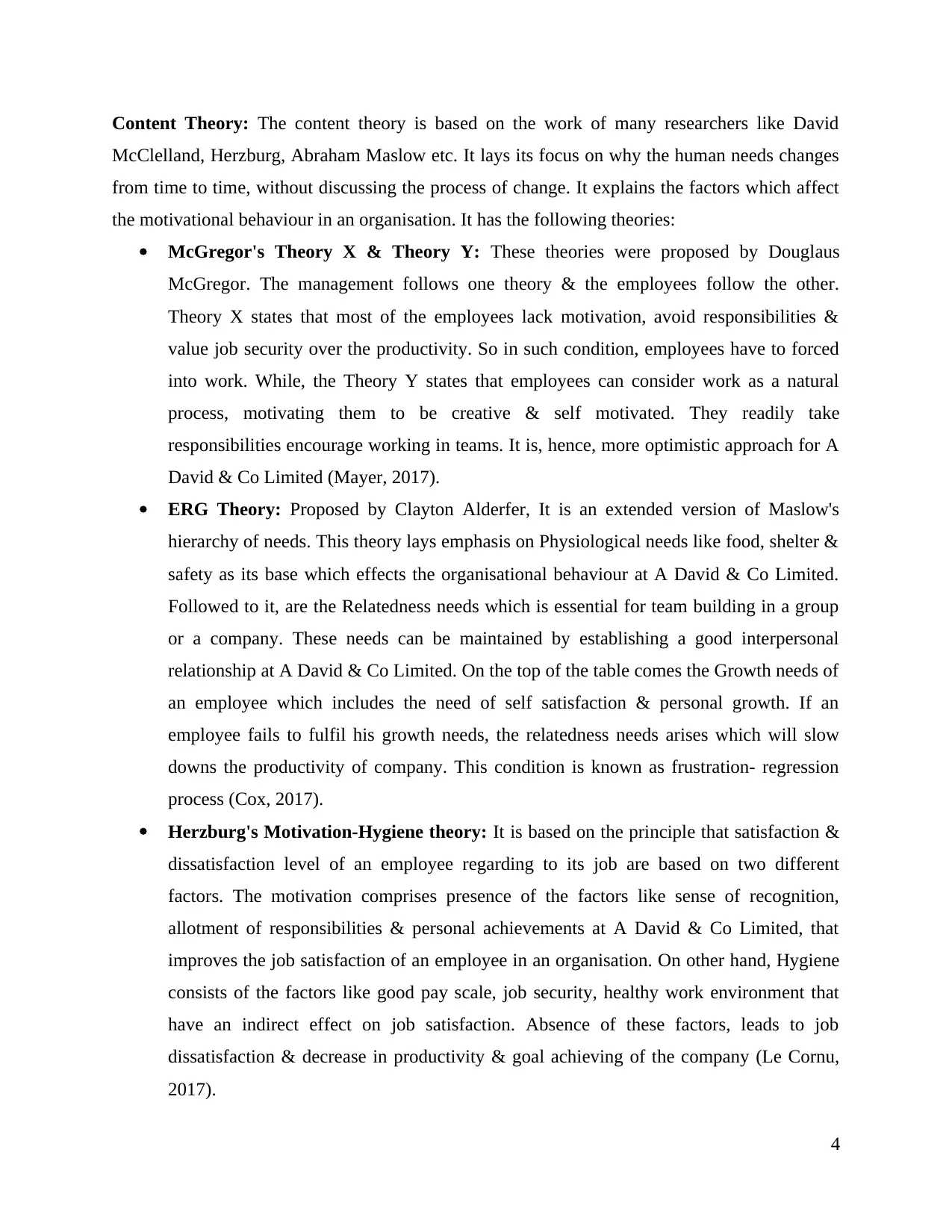
Content Theory: The content theory is based on the work of many researchers like David
McClelland, Herzburg, Abraham Maslow etc. It lays its focus on why the human needs changes
from time to time, without discussing the process of change. It explains the factors which affect
the motivational behaviour in an organisation. It has the following theories:
McGregor's Theory X & Theory Y: These theories were proposed by Douglaus
McGregor. The management follows one theory & the employees follow the other.
Theory X states that most of the employees lack motivation, avoid responsibilities &
value job security over the productivity. So in such condition, employees have to forced
into work. While, the Theory Y states that employees can consider work as a natural
process, motivating them to be creative & self motivated. They readily take
responsibilities encourage working in teams. It is, hence, more optimistic approach for A
David & Co Limited (Mayer, 2017).
ERG Theory: Proposed by Clayton Alderfer, It is an extended version of Maslow's
hierarchy of needs. This theory lays emphasis on Physiological needs like food, shelter &
safety as its base which effects the organisational behaviour at A David & Co Limited.
Followed to it, are the Relatedness needs which is essential for team building in a group
or a company. These needs can be maintained by establishing a good interpersonal
relationship at A David & Co Limited. On the top of the table comes the Growth needs of
an employee which includes the need of self satisfaction & personal growth. If an
employee fails to fulfil his growth needs, the relatedness needs arises which will slow
downs the productivity of company. This condition is known as frustration- regression
process (Cox, 2017).
Herzburg's Motivation-Hygiene theory: It is based on the principle that satisfaction &
dissatisfaction level of an employee regarding to its job are based on two different
factors. The motivation comprises presence of the factors like sense of recognition,
allotment of responsibilities & personal achievements at A David & Co Limited, that
improves the job satisfaction of an employee in an organisation. On other hand, Hygiene
consists of the factors like good pay scale, job security, healthy work environment that
have an indirect effect on job satisfaction. Absence of these factors, leads to job
dissatisfaction & decrease in productivity & goal achieving of the company (Le Cornu,
2017).
4
McClelland, Herzburg, Abraham Maslow etc. It lays its focus on why the human needs changes
from time to time, without discussing the process of change. It explains the factors which affect
the motivational behaviour in an organisation. It has the following theories:
McGregor's Theory X & Theory Y: These theories were proposed by Douglaus
McGregor. The management follows one theory & the employees follow the other.
Theory X states that most of the employees lack motivation, avoid responsibilities &
value job security over the productivity. So in such condition, employees have to forced
into work. While, the Theory Y states that employees can consider work as a natural
process, motivating them to be creative & self motivated. They readily take
responsibilities encourage working in teams. It is, hence, more optimistic approach for A
David & Co Limited (Mayer, 2017).
ERG Theory: Proposed by Clayton Alderfer, It is an extended version of Maslow's
hierarchy of needs. This theory lays emphasis on Physiological needs like food, shelter &
safety as its base which effects the organisational behaviour at A David & Co Limited.
Followed to it, are the Relatedness needs which is essential for team building in a group
or a company. These needs can be maintained by establishing a good interpersonal
relationship at A David & Co Limited. On the top of the table comes the Growth needs of
an employee which includes the need of self satisfaction & personal growth. If an
employee fails to fulfil his growth needs, the relatedness needs arises which will slow
downs the productivity of company. This condition is known as frustration- regression
process (Cox, 2017).
Herzburg's Motivation-Hygiene theory: It is based on the principle that satisfaction &
dissatisfaction level of an employee regarding to its job are based on two different
factors. The motivation comprises presence of the factors like sense of recognition,
allotment of responsibilities & personal achievements at A David & Co Limited, that
improves the job satisfaction of an employee in an organisation. On other hand, Hygiene
consists of the factors like good pay scale, job security, healthy work environment that
have an indirect effect on job satisfaction. Absence of these factors, leads to job
dissatisfaction & decrease in productivity & goal achieving of the company (Le Cornu,
2017).
4
⊘ This is a preview!⊘
Do you want full access?
Subscribe today to unlock all pages.

Trusted by 1+ million students worldwide
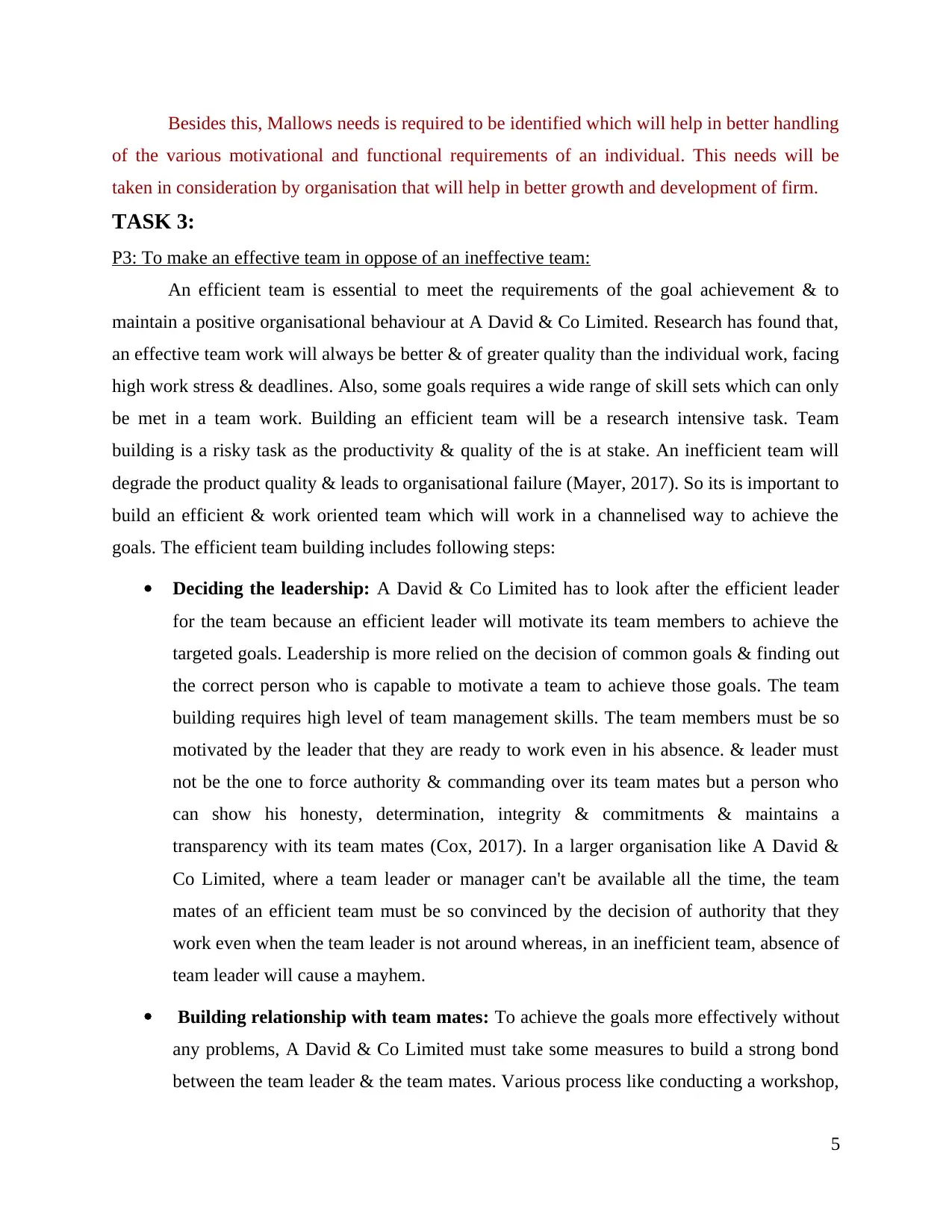
Besides this, Mallows needs is required to be identified which will help in better handling
of the various motivational and functional requirements of an individual. This needs will be
taken in consideration by organisation that will help in better growth and development of firm.
TASK 3:
P3: To make an effective team in oppose of an ineffective team:
An efficient team is essential to meet the requirements of the goal achievement & to
maintain a positive organisational behaviour at A David & Co Limited. Research has found that,
an effective team work will always be better & of greater quality than the individual work, facing
high work stress & deadlines. Also, some goals requires a wide range of skill sets which can only
be met in a team work. Building an efficient team will be a research intensive task. Team
building is a risky task as the productivity & quality of the is at stake. An inefficient team will
degrade the product quality & leads to organisational failure (Mayer, 2017). So its is important to
build an efficient & work oriented team which will work in a channelised way to achieve the
goals. The efficient team building includes following steps:
Deciding the leadership: A David & Co Limited has to look after the efficient leader
for the team because an efficient leader will motivate its team members to achieve the
targeted goals. Leadership is more relied on the decision of common goals & finding out
the correct person who is capable to motivate a team to achieve those goals. The team
building requires high level of team management skills. The team members must be so
motivated by the leader that they are ready to work even in his absence. & leader must
not be the one to force authority & commanding over its team mates but a person who
can show his honesty, determination, integrity & commitments & maintains a
transparency with its team mates (Cox, 2017). In a larger organisation like A David &
Co Limited, where a team leader or manager can't be available all the time, the team
mates of an efficient team must be so convinced by the decision of authority that they
work even when the team leader is not around whereas, in an inefficient team, absence of
team leader will cause a mayhem.
Building relationship with team mates: To achieve the goals more effectively without
any problems, A David & Co Limited must take some measures to build a strong bond
between the team leader & the team mates. Various process like conducting a workshop,
5
of the various motivational and functional requirements of an individual. This needs will be
taken in consideration by organisation that will help in better growth and development of firm.
TASK 3:
P3: To make an effective team in oppose of an ineffective team:
An efficient team is essential to meet the requirements of the goal achievement & to
maintain a positive organisational behaviour at A David & Co Limited. Research has found that,
an effective team work will always be better & of greater quality than the individual work, facing
high work stress & deadlines. Also, some goals requires a wide range of skill sets which can only
be met in a team work. Building an efficient team will be a research intensive task. Team
building is a risky task as the productivity & quality of the is at stake. An inefficient team will
degrade the product quality & leads to organisational failure (Mayer, 2017). So its is important to
build an efficient & work oriented team which will work in a channelised way to achieve the
goals. The efficient team building includes following steps:
Deciding the leadership: A David & Co Limited has to look after the efficient leader
for the team because an efficient leader will motivate its team members to achieve the
targeted goals. Leadership is more relied on the decision of common goals & finding out
the correct person who is capable to motivate a team to achieve those goals. The team
building requires high level of team management skills. The team members must be so
motivated by the leader that they are ready to work even in his absence. & leader must
not be the one to force authority & commanding over its team mates but a person who
can show his honesty, determination, integrity & commitments & maintains a
transparency with its team mates (Cox, 2017). In a larger organisation like A David &
Co Limited, where a team leader or manager can't be available all the time, the team
mates of an efficient team must be so convinced by the decision of authority that they
work even when the team leader is not around whereas, in an inefficient team, absence of
team leader will cause a mayhem.
Building relationship with team mates: To achieve the goals more effectively without
any problems, A David & Co Limited must take some measures to build a strong bond
between the team leader & the team mates. Various process like conducting a workshop,
5
Paraphrase This Document
Need a fresh take? Get an instant paraphrase of this document with our AI Paraphraser
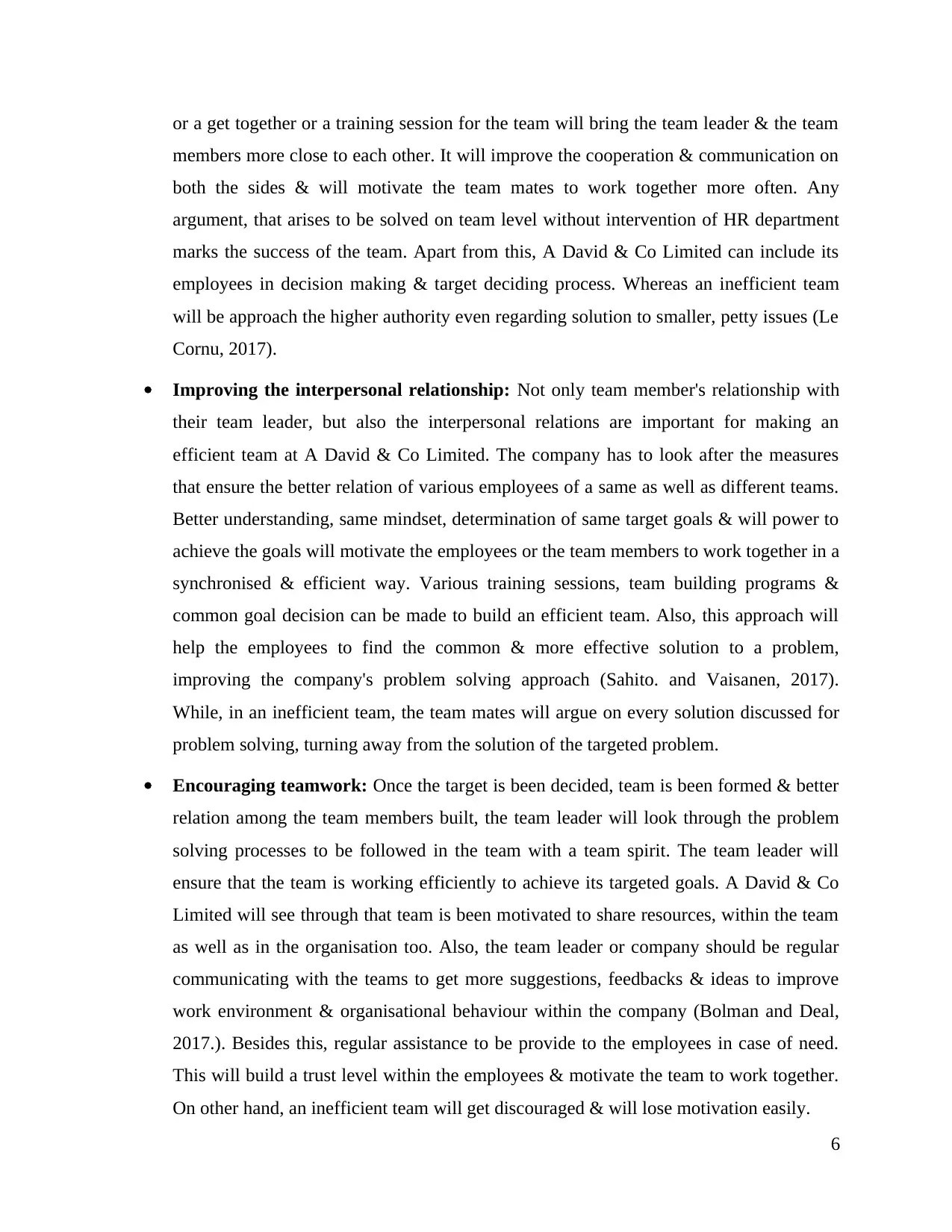
or a get together or a training session for the team will bring the team leader & the team
members more close to each other. It will improve the cooperation & communication on
both the sides & will motivate the team mates to work together more often. Any
argument, that arises to be solved on team level without intervention of HR department
marks the success of the team. Apart from this, A David & Co Limited can include its
employees in decision making & target deciding process. Whereas an inefficient team
will be approach the higher authority even regarding solution to smaller, petty issues (Le
Cornu, 2017).
Improving the interpersonal relationship: Not only team member's relationship with
their team leader, but also the interpersonal relations are important for making an
efficient team at A David & Co Limited. The company has to look after the measures
that ensure the better relation of various employees of a same as well as different teams.
Better understanding, same mindset, determination of same target goals & will power to
achieve the goals will motivate the employees or the team members to work together in a
synchronised & efficient way. Various training sessions, team building programs &
common goal decision can be made to build an efficient team. Also, this approach will
help the employees to find the common & more effective solution to a problem,
improving the company's problem solving approach (Sahito. and Vaisanen, 2017).
While, in an inefficient team, the team mates will argue on every solution discussed for
problem solving, turning away from the solution of the targeted problem.
Encouraging teamwork: Once the target is been decided, team is been formed & better
relation among the team members built, the team leader will look through the problem
solving processes to be followed in the team with a team spirit. The team leader will
ensure that the team is working efficiently to achieve its targeted goals. A David & Co
Limited will see through that team is been motivated to share resources, within the team
as well as in the organisation too. Also, the team leader or company should be regular
communicating with the teams to get more suggestions, feedbacks & ideas to improve
work environment & organisational behaviour within the company (Bolman and Deal,
2017.). Besides this, regular assistance to be provide to the employees in case of need.
This will build a trust level within the employees & motivate the team to work together.
On other hand, an inefficient team will get discouraged & will lose motivation easily.
6
members more close to each other. It will improve the cooperation & communication on
both the sides & will motivate the team mates to work together more often. Any
argument, that arises to be solved on team level without intervention of HR department
marks the success of the team. Apart from this, A David & Co Limited can include its
employees in decision making & target deciding process. Whereas an inefficient team
will be approach the higher authority even regarding solution to smaller, petty issues (Le
Cornu, 2017).
Improving the interpersonal relationship: Not only team member's relationship with
their team leader, but also the interpersonal relations are important for making an
efficient team at A David & Co Limited. The company has to look after the measures
that ensure the better relation of various employees of a same as well as different teams.
Better understanding, same mindset, determination of same target goals & will power to
achieve the goals will motivate the employees or the team members to work together in a
synchronised & efficient way. Various training sessions, team building programs &
common goal decision can be made to build an efficient team. Also, this approach will
help the employees to find the common & more effective solution to a problem,
improving the company's problem solving approach (Sahito. and Vaisanen, 2017).
While, in an inefficient team, the team mates will argue on every solution discussed for
problem solving, turning away from the solution of the targeted problem.
Encouraging teamwork: Once the target is been decided, team is been formed & better
relation among the team members built, the team leader will look through the problem
solving processes to be followed in the team with a team spirit. The team leader will
ensure that the team is working efficiently to achieve its targeted goals. A David & Co
Limited will see through that team is been motivated to share resources, within the team
as well as in the organisation too. Also, the team leader or company should be regular
communicating with the teams to get more suggestions, feedbacks & ideas to improve
work environment & organisational behaviour within the company (Bolman and Deal,
2017.). Besides this, regular assistance to be provide to the employees in case of need.
This will build a trust level within the employees & motivate the team to work together.
On other hand, an inefficient team will get discouraged & will lose motivation easily.
6
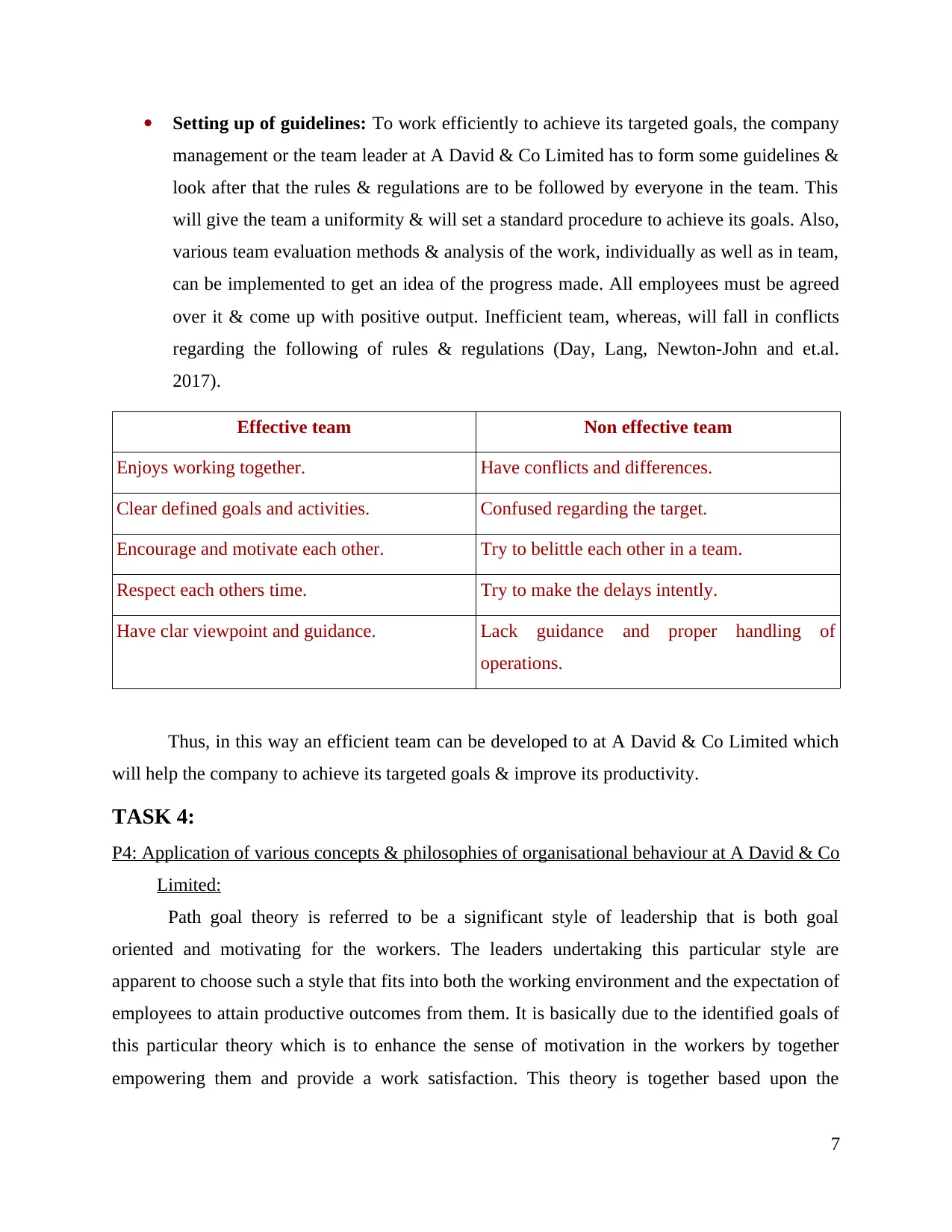
Setting up of guidelines: To work efficiently to achieve its targeted goals, the company
management or the team leader at A David & Co Limited has to form some guidelines &
look after that the rules & regulations are to be followed by everyone in the team. This
will give the team a uniformity & will set a standard procedure to achieve its goals. Also,
various team evaluation methods & analysis of the work, individually as well as in team,
can be implemented to get an idea of the progress made. All employees must be agreed
over it & come up with positive output. Inefficient team, whereas, will fall in conflicts
regarding the following of rules & regulations (Day, Lang, Newton‐John and et.al.
2017).
Effective team Non effective team
Enjoys working together. Have conflicts and differences.
Clear defined goals and activities. Confused regarding the target.
Encourage and motivate each other. Try to belittle each other in a team.
Respect each others time. Try to make the delays intently.
Have clar viewpoint and guidance. Lack guidance and proper handling of
operations.
Thus, in this way an efficient team can be developed to at A David & Co Limited which
will help the company to achieve its targeted goals & improve its productivity.
TASK 4:
P4: Application of various concepts & philosophies of organisational behaviour at A David & Co
Limited:
Path goal theory is referred to be a significant style of leadership that is both goal
oriented and motivating for the workers. The leaders undertaking this particular style are
apparent to choose such a style that fits into both the working environment and the expectation of
employees to attain productive outcomes from them. It is basically due to the identified goals of
this particular theory which is to enhance the sense of motivation in the workers by together
empowering them and provide a work satisfaction. This theory is together based upon the
7
management or the team leader at A David & Co Limited has to form some guidelines &
look after that the rules & regulations are to be followed by everyone in the team. This
will give the team a uniformity & will set a standard procedure to achieve its goals. Also,
various team evaluation methods & analysis of the work, individually as well as in team,
can be implemented to get an idea of the progress made. All employees must be agreed
over it & come up with positive output. Inefficient team, whereas, will fall in conflicts
regarding the following of rules & regulations (Day, Lang, Newton‐John and et.al.
2017).
Effective team Non effective team
Enjoys working together. Have conflicts and differences.
Clear defined goals and activities. Confused regarding the target.
Encourage and motivate each other. Try to belittle each other in a team.
Respect each others time. Try to make the delays intently.
Have clar viewpoint and guidance. Lack guidance and proper handling of
operations.
Thus, in this way an efficient team can be developed to at A David & Co Limited which
will help the company to achieve its targeted goals & improve its productivity.
TASK 4:
P4: Application of various concepts & philosophies of organisational behaviour at A David & Co
Limited:
Path goal theory is referred to be a significant style of leadership that is both goal
oriented and motivating for the workers. The leaders undertaking this particular style are
apparent to choose such a style that fits into both the working environment and the expectation of
employees to attain productive outcomes from them. It is basically due to the identified goals of
this particular theory which is to enhance the sense of motivation in the workers by together
empowering them and provide a work satisfaction. This theory is together based upon the
7
⊘ This is a preview!⊘
Do you want full access?
Subscribe today to unlock all pages.

Trusted by 1+ million students worldwide
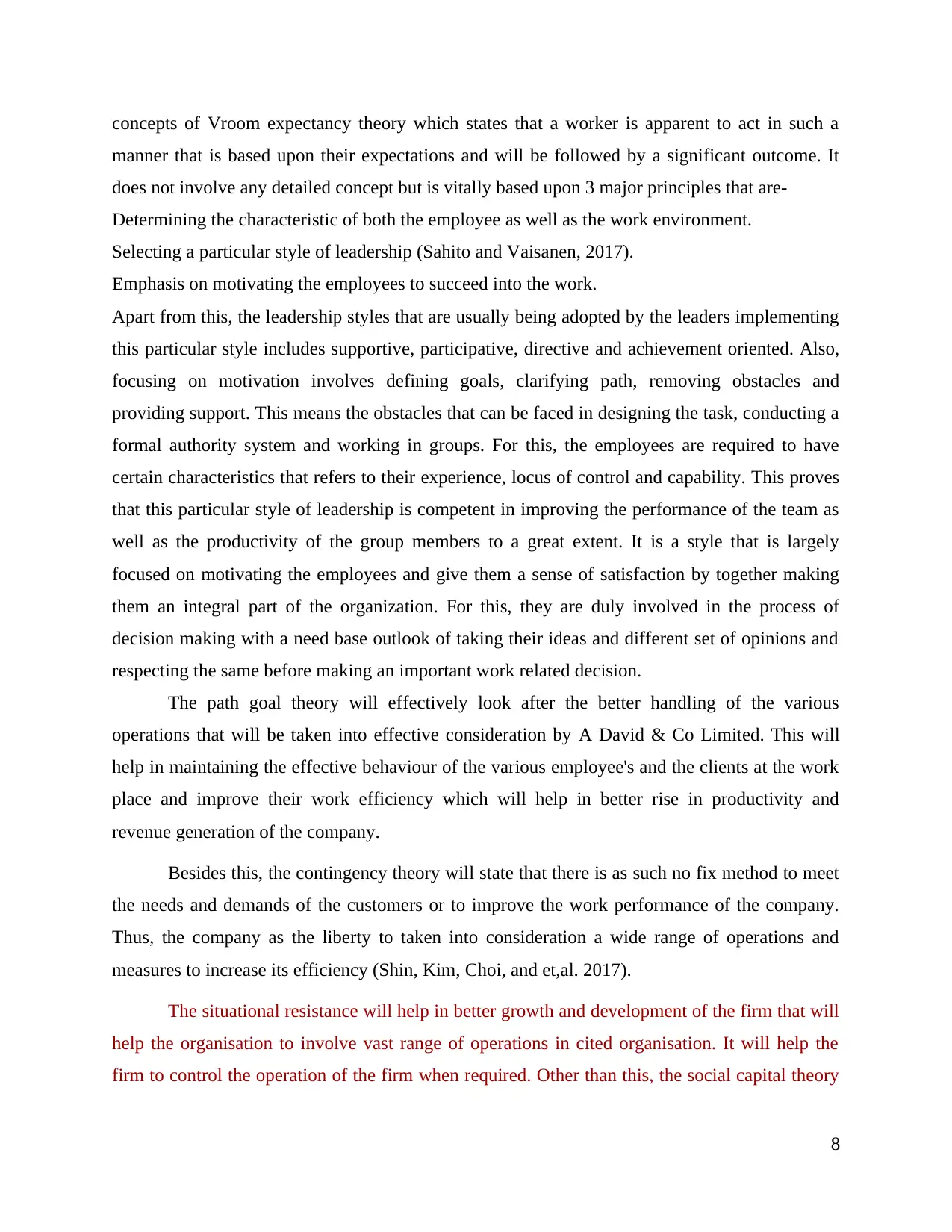
concepts of Vroom expectancy theory which states that a worker is apparent to act in such a
manner that is based upon their expectations and will be followed by a significant outcome. It
does not involve any detailed concept but is vitally based upon 3 major principles that are-
Determining the characteristic of both the employee as well as the work environment.
Selecting a particular style of leadership (Sahito and Vaisanen, 2017).
Emphasis on motivating the employees to succeed into the work.
Apart from this, the leadership styles that are usually being adopted by the leaders implementing
this particular style includes supportive, participative, directive and achievement oriented. Also,
focusing on motivation involves defining goals, clarifying path, removing obstacles and
providing support. This means the obstacles that can be faced in designing the task, conducting a
formal authority system and working in groups. For this, the employees are required to have
certain characteristics that refers to their experience, locus of control and capability. This proves
that this particular style of leadership is competent in improving the performance of the team as
well as the productivity of the group members to a great extent. It is a style that is largely
focused on motivating the employees and give them a sense of satisfaction by together making
them an integral part of the organization. For this, they are duly involved in the process of
decision making with a need base outlook of taking their ideas and different set of opinions and
respecting the same before making an important work related decision.
The path goal theory will effectively look after the better handling of the various
operations that will be taken into effective consideration by A David & Co Limited. This will
help in maintaining the effective behaviour of the various employee's and the clients at the work
place and improve their work efficiency which will help in better rise in productivity and
revenue generation of the company.
Besides this, the contingency theory will state that there is as such no fix method to meet
the needs and demands of the customers or to improve the work performance of the company.
Thus, the company as the liberty to taken into consideration a wide range of operations and
measures to increase its efficiency (Shin, Kim, Choi, and et,al. 2017).
The situational resistance will help in better growth and development of the firm that will
help the organisation to involve vast range of operations in cited organisation. It will help the
firm to control the operation of the firm when required. Other than this, the social capital theory
8
manner that is based upon their expectations and will be followed by a significant outcome. It
does not involve any detailed concept but is vitally based upon 3 major principles that are-
Determining the characteristic of both the employee as well as the work environment.
Selecting a particular style of leadership (Sahito and Vaisanen, 2017).
Emphasis on motivating the employees to succeed into the work.
Apart from this, the leadership styles that are usually being adopted by the leaders implementing
this particular style includes supportive, participative, directive and achievement oriented. Also,
focusing on motivation involves defining goals, clarifying path, removing obstacles and
providing support. This means the obstacles that can be faced in designing the task, conducting a
formal authority system and working in groups. For this, the employees are required to have
certain characteristics that refers to their experience, locus of control and capability. This proves
that this particular style of leadership is competent in improving the performance of the team as
well as the productivity of the group members to a great extent. It is a style that is largely
focused on motivating the employees and give them a sense of satisfaction by together making
them an integral part of the organization. For this, they are duly involved in the process of
decision making with a need base outlook of taking their ideas and different set of opinions and
respecting the same before making an important work related decision.
The path goal theory will effectively look after the better handling of the various
operations that will be taken into effective consideration by A David & Co Limited. This will
help in maintaining the effective behaviour of the various employee's and the clients at the work
place and improve their work efficiency which will help in better rise in productivity and
revenue generation of the company.
Besides this, the contingency theory will state that there is as such no fix method to meet
the needs and demands of the customers or to improve the work performance of the company.
Thus, the company as the liberty to taken into consideration a wide range of operations and
measures to increase its efficiency (Shin, Kim, Choi, and et,al. 2017).
The situational resistance will help in better growth and development of the firm that will
help the organisation to involve vast range of operations in cited organisation. It will help the
firm to control the operation of the firm when required. Other than this, the social capital theory
8
Paraphrase This Document
Need a fresh take? Get an instant paraphrase of this document with our AI Paraphraser
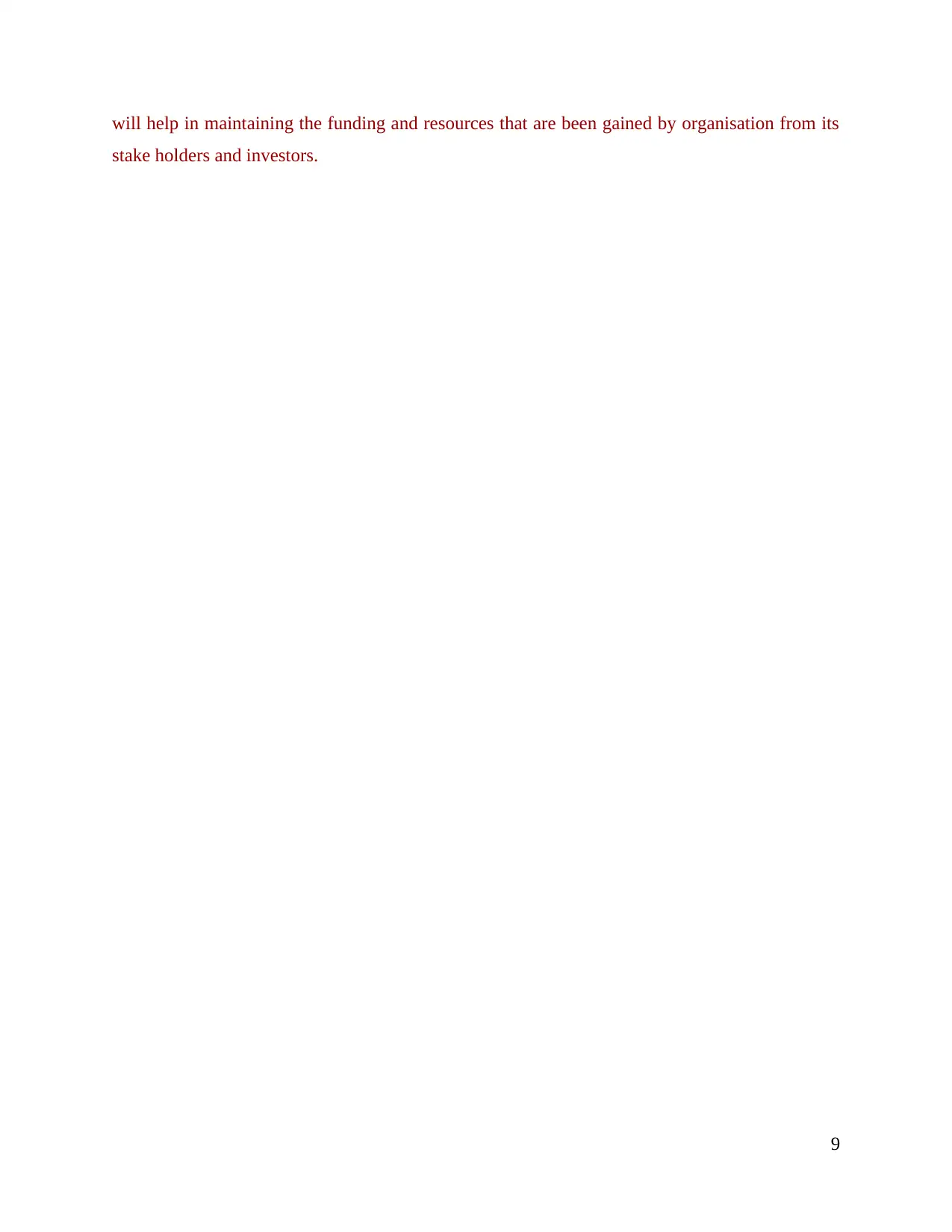
will help in maintaining the funding and resources that are been gained by organisation from its
stake holders and investors.
9
stake holders and investors.
9
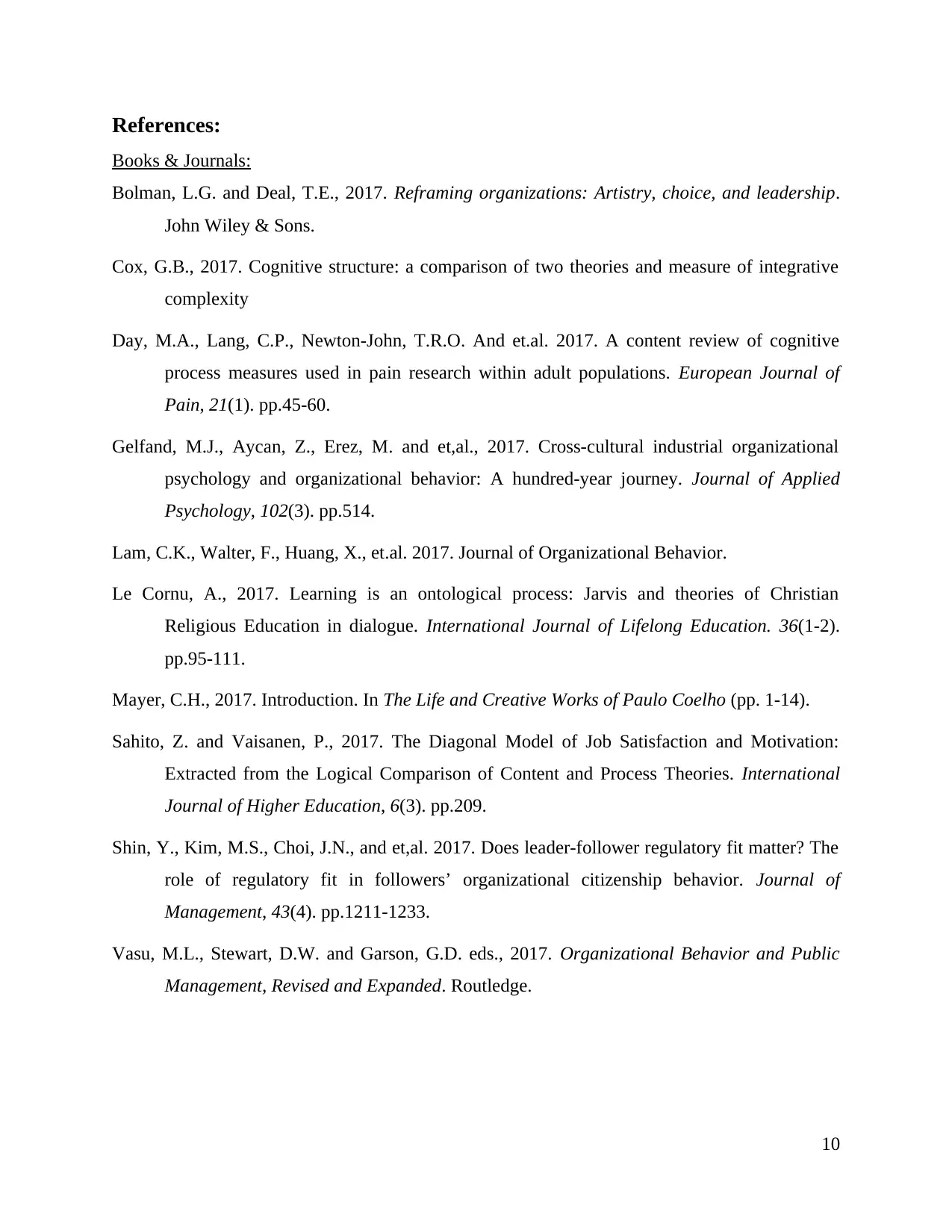
References:
Books & Journals:
Bolman, L.G. and Deal, T.E., 2017. Reframing organizations: Artistry, choice, and leadership.
John Wiley & Sons.
Cox, G.B., 2017. Cognitive structure: a comparison of two theories and measure of integrative
complexity
Day, M.A., Lang, C.P., Newton‐John, T.R.O. And et.al. 2017. A content review of cognitive
process measures used in pain research within adult populations. European Journal of
Pain, 21(1). pp.45-60.
Gelfand, M.J., Aycan, Z., Erez, M. and et,al., 2017. Cross-cultural industrial organizational
psychology and organizational behavior: A hundred-year journey. Journal of Applied
Psychology, 102(3). pp.514.
Lam, C.K., Walter, F., Huang, X., et.al. 2017. Journal of Organizational Behavior.
Le Cornu, A., 2017. Learning is an ontological process: Jarvis and theories of Christian
Religious Education in dialogue. International Journal of Lifelong Education. 36(1-2).
pp.95-111.
Mayer, C.H., 2017. Introduction. In The Life and Creative Works of Paulo Coelho (pp. 1-14).
Sahito, Z. and Vaisanen, P., 2017. The Diagonal Model of Job Satisfaction and Motivation:
Extracted from the Logical Comparison of Content and Process Theories. International
Journal of Higher Education, 6(3). pp.209.
Shin, Y., Kim, M.S., Choi, J.N., and et,al. 2017. Does leader-follower regulatory fit matter? The
role of regulatory fit in followers’ organizational citizenship behavior. Journal of
Management, 43(4). pp.1211-1233.
Vasu, M.L., Stewart, D.W. and Garson, G.D. eds., 2017. Organizational Behavior and Public
Management, Revised and Expanded. Routledge.
10
Books & Journals:
Bolman, L.G. and Deal, T.E., 2017. Reframing organizations: Artistry, choice, and leadership.
John Wiley & Sons.
Cox, G.B., 2017. Cognitive structure: a comparison of two theories and measure of integrative
complexity
Day, M.A., Lang, C.P., Newton‐John, T.R.O. And et.al. 2017. A content review of cognitive
process measures used in pain research within adult populations. European Journal of
Pain, 21(1). pp.45-60.
Gelfand, M.J., Aycan, Z., Erez, M. and et,al., 2017. Cross-cultural industrial organizational
psychology and organizational behavior: A hundred-year journey. Journal of Applied
Psychology, 102(3). pp.514.
Lam, C.K., Walter, F., Huang, X., et.al. 2017. Journal of Organizational Behavior.
Le Cornu, A., 2017. Learning is an ontological process: Jarvis and theories of Christian
Religious Education in dialogue. International Journal of Lifelong Education. 36(1-2).
pp.95-111.
Mayer, C.H., 2017. Introduction. In The Life and Creative Works of Paulo Coelho (pp. 1-14).
Sahito, Z. and Vaisanen, P., 2017. The Diagonal Model of Job Satisfaction and Motivation:
Extracted from the Logical Comparison of Content and Process Theories. International
Journal of Higher Education, 6(3). pp.209.
Shin, Y., Kim, M.S., Choi, J.N., and et,al. 2017. Does leader-follower regulatory fit matter? The
role of regulatory fit in followers’ organizational citizenship behavior. Journal of
Management, 43(4). pp.1211-1233.
Vasu, M.L., Stewart, D.W. and Garson, G.D. eds., 2017. Organizational Behavior and Public
Management, Revised and Expanded. Routledge.
10
⊘ This is a preview!⊘
Do you want full access?
Subscribe today to unlock all pages.

Trusted by 1+ million students worldwide
1 out of 12
Related Documents
Your All-in-One AI-Powered Toolkit for Academic Success.
+13062052269
info@desklib.com
Available 24*7 on WhatsApp / Email
![[object Object]](/_next/static/media/star-bottom.7253800d.svg)
Unlock your academic potential
Copyright © 2020–2025 A2Z Services. All Rights Reserved. Developed and managed by ZUCOL.





